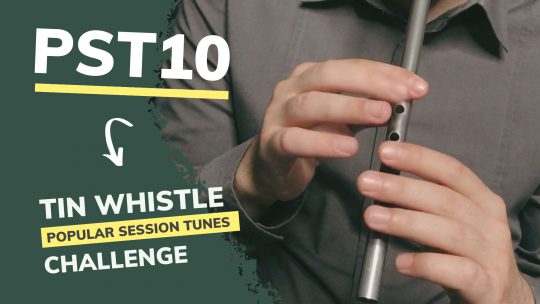Cran (or crann) is another attractive ornament that many tin whistle players consider an advanced one as it’s not easy to comprehend and execute, especially for beginners. It originates from Uilleann pipes (Irish bagpipes) and combines both fingering and rhythmic techniques.
How to play a cran ornament on a tin whistle?
The best synonym of a cran is basically a triple cut. It represents a sequence of three consecutive cuts, played on the same note but executed so that every cut in the row is done with a different finger. For example, we play a note D, and we first cut the note with the finger on G, then on F#, and then on E. If we do so fast enough, we get that “bubbly effect” known as the cran.
In the below video, you can see a breakdown and a demonstration of the cran ornament, followed by a couple of simple exercises to understand how it rhythmically applies to jigs and reels.
Also, keep in mind that the finger ordering used in the sequence of cuts is irrelevant. We demonstrated a G – F# – E series, but you can do the opposite or any other combination. You can also do only two fingers alternately. The key to successfully sounding cran is the speed and the proper internal rhythm of the cuts, not the exact finger ordering.
Why use crans?
Most tin whistle players use crans as a substitute for the roll ornament as it is not possible on a D note (the root note), but it has a similar effect. However, it’s also possible to use crans on a few other notes, such as E, F# and G. All of those notes have at least two fingers above the ornamented note. So, for example, you could play a cran on an E note by cutting with the A, G and F# fingers, and so on. But since rolls are generally easier to accomplish, most people tend to play crans only on D.
Whistle players mostly use crans as an alternative for rolls on D.
LearnTinWhistle.com
The rhythmic characteristics of crans
Although you can use crans on any longer notes in a melody where you think there is enough space for three cuts, they may sound unarticulated without the proper rhythm and good correlation with other notes. So, here is a straightforward rule on correctly incorporating them into Irish tunes. A natural spot to use a cran is the length of a dotted quarter note, also equivalent to three repeated eight notes of the same pitch (especially D notes). So, we play the first eight-note as a plain melody note and then do the three cuts in the space of the remaining two eight notes.
Here’s an image for a better illustration.

You can notice we generally tend to use crans in the same spots as rolls. But unlike rolls that naturally combine two ornaments on two eight notes (a cut and a tap), we need to play three ornaments instead (three cuts). This leads us to the exact rhythm of the Irish triplet.
Long VS short crans
Another thing worth mentioning, what we typically call the cran is considered a long cran. But you can also play a “short” cran (as an analogy with rolls). And you do so if there is a space for two eight notes (one quarter note) only. So, you immediately start with three cuts without playing the first melody note. That’s a short cran.

An example of using crans in tunes
In the video below, see how we use crans in The Blarney Pilgrim (jig) and The Christmas Eve (reel).
And here’s the sheet music and tabs for the examples, as played in the video. Notes on which we are doing crans are marked with the word “CRAN”.






